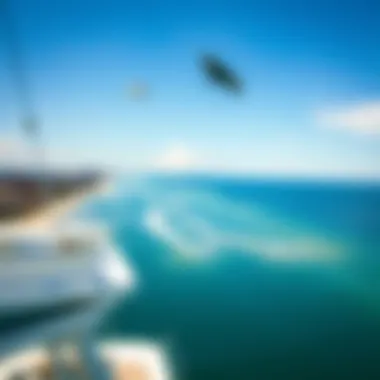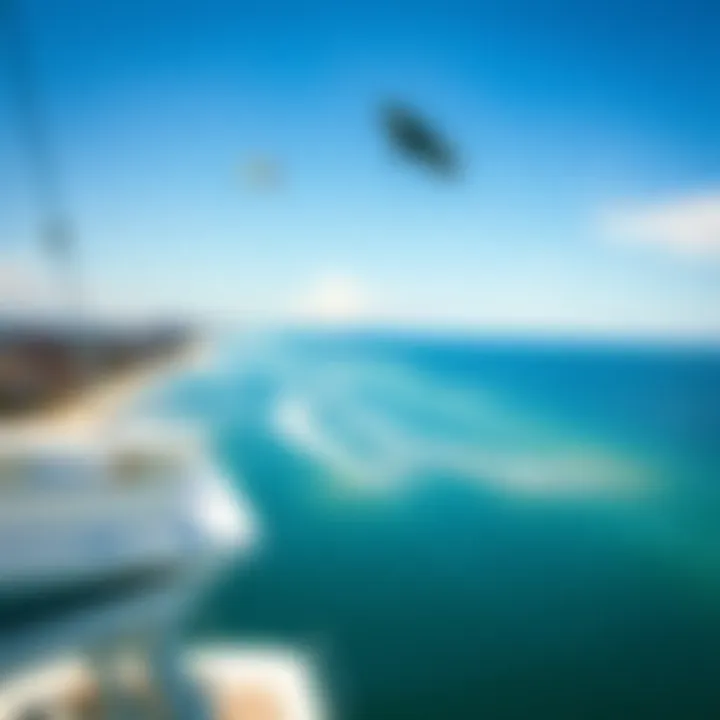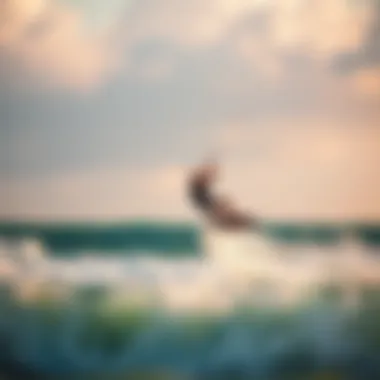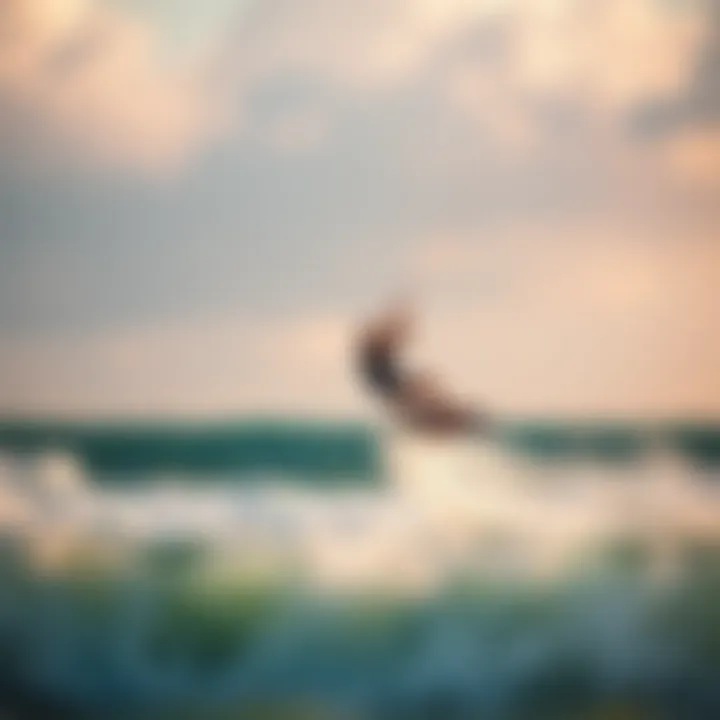Exploring Fort Pierce, FL Weather for Kiteboarding


Intro
Understanding the weather in Fort Pierce, Florida, is like grasping the essence of a quintessential coastal lifestyle. The subtropical climate, which has defined this part of the Sunshine State, brings unique seasonal variations and invites kiteboarding enthusiasts to explore the elements. For kiteboarders, understanding these weather patterns isn’t just a matter of curiosity; it's crucial in honing their skills and planning adventures. In this analysis, we'll dissect how wind, temperature, and seasonal changes come together, impacting not only the kiteboarding experience but also the broader outdoor lifestyle in this vibrant city.
As we dive into the specific sections covering equipment insights and technique exploration, it’s essential to appreciate how local weather conditions intertwine with various kiteboarding practices. With the picturesque backdrop of Fort Pierce, each gust of wind and shift in temperature offers something different for both novices and seasoned pros.
Whether you're looking to catch up on the latest gear, delve into techniques tailored for distinct wind patterns, or simply gain a clearer perspective on what to expect while kiteboarding here, this comprehensive guide covers all that and more.
Overview of Fort Pierce, Florida
Understanding the landscape and vibe of Fort Pierce, Florida, sets the stage for diving into its weather nuances. This coastal city isn’t just another dot on the map; it’s a dynamic part of Florida with its own character. Nestled along the Indian River, Fort Pierce boasts a mix of historical charm and vibrant local culture. For kiteboarders and outdoor enthusiasts, knowing what Fort Pierce has to offer goes beyond just the immediate thrill of the water—it’s about embracing the full experience of this locale.
Geographical Location and Significance
Fort Pierce is strategically located on the east coast of Florida, giving it direct access to the Atlantic Ocean. This not only means miles of shoreline but also influences the weather patterns that define the area. With its latitude placing it in subtropical territory, the region enjoys moderate winters and warm summers, making it a preferred spot for seasonal visitors.
The city's geographical attributes don't stop at the oceanfront. The nearby Indian River Lagoon is one of the most biodiverse estuaries in the U.S., adding to the ecological uniqueness of Fort Pierce. The proximity to such natural beauty also offers diverse opportunities for ecological studies, fishing, and, of course, kiteboarding.
This location’s beauty and climate invite visitors and residents alike to explore the waters and enjoy outdoor spaces year-round.
Economic and Cultural Highlights
The economy of Fort Pierce is a lively tapestry woven with various industries, including tourism, agriculture, and fishing. The vibrant waterfront area serves as a key commercial zone, hosting a range of restaurants, shops, and entertainment options. Notably, the city’s rich maritime heritage is celebrated through events such as the Fort Pierce Seafood Festival and the annual Sailfish Festival, which draws crowds and adds to the vibrant local culture.
Culturally, Fort Pierce is a treasure trove. From historic landmarks like the city’s iconic House of Refuge to the vibrant art scene reflected in local galleries and street art, there’s barely a dull moment. The blend of cultures contributes to a rich fabric of community events and festivals honoring everything from arts to seafood.
Understanding these economic and cultural highlights gives kiteboarding enthusiasts a more well-rounded view of what to expect when they plan their trips. The lively local atmosphere directly enhances the kiteboarding experience, making it not just about the weather, but about connecting with a passionate community.
Understanding Florida's Climate
Understanding Florida's climate is pivotal in grasping how it shapes not just the daily lives of its residents, but also recreational activities like kiteboarding. The state's weather creates a vibrant backdrop for a plethora of outdoor endeavors. Particularly in Fort Pierce, where kiteboarding thrives amid unique climate conditions, knowing the intricacies of local weather can be the difference between a great day on the water and a washout.
The purpose of this segment is to unravel the complexity surrounding Florida’s tropical climate. By diving into specific elements, we can illuminate the benefits of this understanding—like recognizing optimal weather for kiteboarding and the inherent challenges that can arise.
Tropical Climate Characteristics
Florida boasts a tropical climate characterized mainly by warm temperatures and high humidity year-round. In Fort Pierce specifically, expect summer months to be sultry, averaging anywhere from 75°F to 90°F. Winter months are milder, with daytime highs often ranging from 65°F to 80°F.
Key aspects of Florida’s tropical climate include:
- High Humidity: Humidity tends to hang around like an unwanted guest, often exceeding 70%. This can be uncomfortable for some, but serves beneficially for kiteboarding since it keeps the wind currents consistent.
- Consistent Temperature: The temperature variations are generally minor across seasons, ensuring that the water remains conducive for kiteboarding almost year-round.
- Seasonal Rainfall: Florida experiences a distinct wet season from May to October with the bulk of rain falling in the afternoon in the form of short, heavy showers. This can serve as refreshing intervals for kiteboarding sessions.
- Tropical Storms: Specifically from June to November, tropical storms can periodically affect the area. Kiteboarders must stay vigilant during these months, as squalls can quickly disrupt a sunny day.
Florida's climate also allows for the cultivation of diverse ecosystems, supporting various fauna and flora, additionally enriching the atmosphere in which sports enthusiasts operate.
Influence of the Atlantic Ocean
The Atlantic Ocean plays a crucial role in dictating weather patterns in Fort Pierce. Its presence creates a moderating effect on local temperatures and humidity levels, making the coastal city feel more temperate compared to inland areas.
Influences include:
- Wind Patterns: The ocean generates prevailing easterly winds, ideal for kiteboarding. These winds often translate into consistent and enjoyable conditions for riders.
- Temperature Regulation: The ocean absorbs heat during the day and releases it at night, contributing to the relatively stable temperatures experienced throughout the coastal region.
- Storm Formation: The Atlantic can be a breeding ground for storms. As mentioned before, storms are a concern. Thus, understanding tropical weather systems is crucial for anyone planning kiteboarding activities during the storm season.


"Knowledge of our environment allows for not just survival but expertise in mastering it."
As kiteboarding enthusiasts navigate the waters of Fort Pierce, being attuned to the climate influenced by the Atlantic offers an advantage, letting one ride the waves with less concern for unforeseen weather changes. This knowledge arms them to embrace each outing with the awareness necessary for fun yet safe experiences on the water.
Seasonal Weather Patterns in Fort Pierce
Understanding the seasonal weather patterns in Fort Pierce is crucial for kiteboarders and outdoor enthusiasts. These patterns significantly influence the area's kiteboarding conditions, safety, and the overall enjoyment of activities. By grasping how the seasons intertwine with local weather phenomena, one can better prepare for what to expect and make informed choices regarding their kiteboarding adventures. Factors such as wind direction, temperature ranges, and rainfall all interact to create a unique and vibrant environment for water sports. Let’s delve into the specifics of each season.
Winter Conditions
Winter in Fort Pierce, which lasts from December to February, offers a different landscape for kiteboarding. While northern states are buried under snow, Fort Pierce enjoys mild temperatures. Average highs hover around 70°F (21°C) and lows dip to about 50°F (10°C).
During this time, winds are predominantly from the northeast, generating appealing wind conditions. Kiteboarders can relish in comfortable sessions, yet it can be tricky due to variable wind strength. It’s not unusual for days to start calm and then pick up in the afternoon, so monitoring forecasts is essential. The calm days provide opportunities for newbie kiteboarders to learn without the fear of harsh winds. It's a delightful time for many to enjoy the water without the sweltering heat that comes later in the year.
Spring Transitions
As winter wanes and spring takes hold, typically from March to May, Fort Pierce sees a noticeable shift in temperatures. Spring averages around 75°F (24°C) high during the day, gently warming up the air.
Winds transition from the northeast to an increasingly east-southeast flow, which can vary in speed and consistency. This transitional period brings warm weather and a steadier wind pattern, making it a favorite for kiteboarders.
Rainfall begins to increase in late spring, but it often comes in short bursts, leaving plenty of sunshine in between. Being prepared for quick weather changes is prudent. Kiteboarders should take advantage of those windy days and soak up the sun, honing their skills as they slowly creep into the busier summer months.
Summer Heat and Humidity
Summer, spanning June to August, transforms Fort Pierce into a tropical sanctuary, with average temperatures soaring to 90°F (32°C) or more. This season is characterized not only by high temperatures but also by significant humidity, making it feel even warmer. Winds establish themselves from the east, and while they may be lighter in the early morning, they generally pick up in the afternoon, creating ideal conditions for kiteboarding.
Despite the alluring ocean breeze, summer also brings the potential for afternoon thunderstorms. These storms can pop up quickly, so kiteboarders need to be astute about weather patterns and ready to land their kites should dark clouds roll in. Understanding how to gauge storm approaches can ensure safety and enjoyment on the water.
Fall Precipitation Patterns
As summer fades into fall, from September to November, Fort Pierce experiences a significant drop in humidity and temperature. Average highs settle around 80°F (27°C), providing a very comfortable backdrop for outdoor activities. Fall also marks the end of the hurricane season, though lingering storm systems can still cause sporadic rain.
Winds in the fall tend to be variable, with a mix of easterlies and light breezes. This season presents excellent opportunities for kiteboarding, particularly in October and November, when winds can still be robust without the summertime intensity.
Overall, the fall season ushers in an ideal combination of pleasant temperatures and manageable winds. It’s a time when kiteboarders can really enjoy a range of conditions without battling the extremes found in summer.
In summary, grasping the seasonal weather patterns in Fort Pierce equips kiteboarders with the knowledge needed to optimize their experiences, highlighting the importance of being prepared and informed.
Wind Patterns and Their Relevance to Kiteboarding
Understanding wind patterns is crucial for kiteboarding enthusiasts in Fort Pierce, Florida. Kiteboarding relies heavily on consistent winds, with specific wind directions playing a significant role in determining the quality of the riding experience. In this section, we will explore the prevailing winds, their seasonal variations, and how they impact kiteboarding activities in this coastal paradise.
Prevailing Winds in Fort Pierce
Fort Pierce generally benefits from steady trade winds that flow from the east-southeast. These winds are often consistent and reliable, making them ideal for both novice and experienced kiteboarders. The typical wind directions create a favorable environment, allowing riders to maximize their time on the water. The dominant wind directions can be summarized as follows:
- East-Southeast (ESE): This is the primary direction for kiteboarding in Fort Pierce. Winds from this angle provide favorable conditions for downwinders and freestyle maneuvers.
- South-Southeast (SSE): Another common wind direction, SSE winds often lead to a slightly more challenging ride but can provide thrilling experiences during summer months.
- Northeast (NE): While not as frequent, NE winds can offer fun kiteboarding conditions, particularly in the spring when winds tend to shift.
Kiteboarders familiar with these prevailing winds can better plan their outings and optimize their experiences on the water. Having the wind at your back can turn a good day into a great one, ensuring that each kiteboarding session is both exhilarating and safe.
Wind Speed Variations by Season
Seasonal changes can also affect wind speeds, leading to noticeable variations throughout the year. Understanding these patterns enables kiteboarders to select the best times for their activities. Here’s a brief breakdown:
- Winter: Generally, wind speeds during winter months can reach 15 to 25 knots, offering ideal conditions for experienced riders. The cooler temperatures and enhanced wind dynamics create a thrilling atmosphere.
- Spring: As the weather warms, wind speeds tend to be slightly less consistent, often fluctuating between 10 to 20 knots. This variability makes spring an exciting time for kiteboarders looking to test their skills with shifting conditions.
- Summer: Wind speeds can soar, with averages ranging from 10 to 15 knots. Although summer sweetness might favor some, heat and humidity levels can result in only weak winds, making it important for kiteboarders to stay vigilant about wind forecasts.
- Fall: The fall season sees a return of stronger winds, often averaging between 15 to 20 knots. These winds create ideal conditions for all skill levels, as kiteboarders can enjoy both the comfort of the re-emerging cooler temperatures and the thrill of robust winds.


Rainfall and its Implications for Outdoor Activities
Understanding rainfall in Fort Pierce, Florida isn’t just a matter of curiosity; it’s crucial for anyone interested in outdoor pursuits, especially kiteboarding. Rainfall impacts not only the water conditions but also the overall experience of engaging in outdoor activities. Kiteboarders, for instance, often look closely at weather forecasts, as a sudden rain shower can be a game changer. This section will break down average rainfall statistics, and the correlation between rain and kiteboarding conditions, providing insights that are essential for serious enthusiasts.
Average Rainfall Statistics
Fort Pierce exhibits a fairly unique rainfall pattern throughout the year. On average, the city receives about 58 inches of rain annually, which is significantly higher than the national average.
- Key monthly averages:
- January: 2.5 inches
- April: 2.8 inches
- July: 7.5 inches
- October: 6.6 inches
Rainfall is heavily concentrated during the summer months, particularly from June to September, which coincides with the hurricane season in Florida. It's during this season that kiteboarders may overlap their activities with rainfall, which often leads to unpredictable conditions.
Research points to certain trends:
Rain is not evenly distributed across the year. The summer months can be heavy with short, intense storms, while winters are milder, resulting in lower averages. Understanding these statistics can help kiteboarding enthusiasts plan their outings effectively, often aiming to take advantage of rain-free days or using storm systems to their advantage.
Impact of Rain on Kiteboarding Conditions
Rain can present both opportunities and challenges for kiteboarders in Fort Pierce. On one hand, a light rain can actually improve water conditions. The added fresh water can make the ocean slightly smoother, reducing choppiness, especially beneficial for those skilled in jumps and tricks.
However, heavy rains typically come with strong winds and turbulent weather patterns, which can be counterproductive for kiteboarding. The shifting winds may create dangers that even seasoned kiteboarders need to recognize and react to swiftly.
"Understanding how rain affects wind patterns is crucial. A sudden shift can change a perfect day on the water into a challenging one."
In essence, whether rain enhances or disrupts kiteboarding hinges on its intensity and accompanying conditions. It’s wise to remain adaptable and prepared when heading out, being mindful of the forecast not just for rain, but also for wind speed and direction.
Ultimately, an astute kiteboarder will integrate rainfall patterns into their planning, thus optimizing their time on the water while mitigating risks associated with abrupt weather changes.
Temperature Trends and Comfort Levels
Understanding temperature trends and comfort levels is crucial for kiteboarders who wish to maximize their experience on the water. Fort Pierce, situated in the heart of Florida’s Treasure Coast, showcases a range of temperatures throughout the year. These fluctuations play a pivotal role in influencing the overall kiteboarding conditions, affecting everything from gear choices to session duration.
Key Elements to Consider:
- Temperature Variability: Kiteboarders should note that the average temperatures can swing significantly between seasons. For instance, winter in Fort Pierce tends to be mild but can bring unexpected cool spells, while summer offers heat that can soar and lead to sweltering conditions.
- Comfort Levels: The comfort level influenced by temperature not only informs packing choices but also affects physical performance on the water. Extreme heat can lead to fatigue and injuries if caution isn’t taken. Conversely, cooler winds can be refreshing but may require appropriate attire to prevent chills during lengthy sessions.
Historical Temperature Data
Over the years, historical temperature data has painted a vivid picture of Fort Pierce's climate. The average temperature hovers around 75°F (24°C) annually, but seasonal patterns present distinct characteristics.
- Winter (December-February): The winter months see daytime highs typically in the upper 60s to mid-70s°F (15-24°C). Nights can get chilly, dipping into the low 50s°F (10-15°C). Kiteboarders during this period might need a light wetsuit or jacket, especially in the evenings.
- Spring (March-May): As temperatures begin to warm up, spring brings highs in the 70s to mid-80s°F (21-29°C). This is often considered the ideal time for kiteboarding, as wind conditions become more stable, and the water is generally inviting.
- Summer (June-August): Expect temperatures to climb into the upper 80s and lower 90s°F (27-34°C) with high humidity. Kiteboarders must mind hydration, as prolonged exposure can lead to heat-related ailments. Morning sessions are usually cooler, making them preferable.
- Fall (September-November): The fall months experience a gradual cooling, averaging high temperatures in the low to mid-80s°F (27-30°C). This season often sees increased hurricane activity, which can introduce significant weather changes, affecting conditions.
Utilizing resources like NOAA can help kiteboarders stay updated on historical and current temperature data specific to Fort Pierce, ensuring informed decisions about their outings.
Optimal Temperature Ranges for Kiteboarding
Kiteboarding enthusiasts thrive within certain temperature ranges that strike a balance between comfort and optimal performance. Based on extensive experience and local insights, here are the optimal conditions:
- Ideal Ranges: Most kiteboarders find that conditions between 70°F to 85°F (21°C to 29°C) are prime for riding. This range tends to combine moderate warmth with pleasant winds, making sessions enjoyable yet manageable.
- Wind Considerations: The efficiency of kiteboarding isn't just about temperature; it's also significantly affected by wind patterns that accompany these temperatures. A consistent wind speed of around 15-20 knots is generally regarded as perfect for kiteboarding bliss.
- Gear Adjustments: Variation in temperature should dictate gear choices. A shorty wetsuit may be suitable during cooler winds in spring, while lightweight board shorts or rash guards can suffice during the steamy summer months.
"Being aware of temperature trends and adjusting accordingly can transform an average session into an extraordinary one!"


Optimizing these considerations leads to not just better performance but also lasting memories out on the water.
Forecasting Weather for Kiteboarding Activities
Forecasting weather is vital for kiteboarding activities in Fort Pierce, FL. Kiteboarders require precise information on wind speed, direction, and potential precipitation to ensure safe and enjoyable experiences. Here’s a breakdown of why this topic is significant for enthusiasts and how it can enhance their kiteboarding adventures.
Weather forecasts help kiteboarders plan their outings effectively. Knowledge of upcoming conditions can differentiate between a day of thrilling rides over idyllic waves and one spent stuck inside awaiting a storm’s passing. This knowledge gives riders the upper hand, as detailed forecasts can highlight optimal kite surfing conditions.
When kiteboarders familiarize themselves with the local forecast, it stirs confidence. Understanding forecasts can mean the difference between a thrilling experience and a content time wasted. With so many apps and tools today, accessing necessary data becomes easier than ever. However, while technology simplifies this task, interpreting forecasts accurately and contextualizing them to local patterns remains crucial.
Utilizing Weather Apps and Websites
Weather apps and websites serve as invaluable tools for kiteboarders in Fort Pierce. Many platforms aggregate real-time data, forecasting wind conditions, temperatures, and precipitation. Here are a few must-have resources:
- Windy: This site offers detailed forecasts involving wind speeds, making it a favorite among kiteboarders. You can visualize wind patterns using a sleek interface.
- Magic Seaweed: While primarily aimed at surfers, many kiteboarders use it for reliable surf forecasts, including wind information.
- Windfinder: A straightforward site dedicated to wind forecasts. Here, users can find historical data to compare current conditions with past trends.
- NOAA (National Oceanic and Atmospheric Administration): For those preferring official information, NOAA covers local forecasts and weather warnings, ensuring you stay informed.
The wealth of options may seem daunting, but tailoring your app choices based on personal preferences or the specific kiting locations around Fort Pierce proves essential. For example, a user might prioritize wind forecasts for a specific beach, while another may seek broad weather patterns across the area.
Understanding Meteorological Terminology
Understanding basic meteorological terminology is also important in interpreting the information these apps provide. Here are a few common terms that kiteboarders should grasp:
- Wind Gusts: Sudden spikes in wind speed can affect kite control. Knowing peak gust speeds aids in determining if conditions suit your skill level.
- Barometric Pressure: Changes in this pressure can indicate approaching weather systems. A falling barometer often suggests a storm is brewing.
- Isobars: Lines indicating equal pressure on weather maps; closely spaced isobars signal strong winds, which can enhance kiteboarding conditions.
- Cumulus Clouds: These clouds usually indicate fair weather but can develop into storm clouds if they grow large enough. Keeping an eye on cloud formations can be helpful for kiteboarders.
Familiarity with these terms allows kiteboarders to connect with the weather data they receive and analyze it more effectively, ultimately enhancing their on-water experience.
Local Resources for Staying Informed
In the world of kiteboarding, staying abreast of the weather is akin to having a sturdy kite and a well-packed bag. This section focuses on the local resources available for those eager to embrace the winds of Fort Pierce, Florida. Being informed can mean the difference between a day of soaring through the skies and one spent on the beach looking at calm waters. Here, we'll delve into two key aspects: Weather Stations and Monitoring Tools and Connecting with Local Kiteboarding Communities.
Weather Stations and Monitoring Tools
Fort Pierce is home to a network of weather stations that offer real-time data crucial for kiteboarders. These stations track variables like wind speed, air pressure, and humidity, all of which are vital for determining optimal kiteboarding conditions. Sites such as Weather Underground and the National Weather Service (weather.gov) deliver forecasts, alerts, and access to live data from nearby weather stations.
Additionally, there are user-friendly mobile apps that kiteboarders can access on the go. Apps like Windy, iKitesurf, or MyRadar not only provide detailed wind forecasts but also include user-generated reports. This way, you can check in on what conditions are like at different spots around Fort Pierce without having to take a trip yourself. The immediacy of this information enriches the experience and helps ensure safety on the water.
Furthermore, these monitoring tools can be indispensable for understanding seasonal variations. For instance, observing trends like increasing wind velocity leading into summer can guide planning. As the seasoned kite enthusiasts say, “you gotta check your wind before you spin.” Knowing where and when the best winds blow allows kiteboarders to make the most of their time.
Connecting with Local Kiteboarding Communities
Another golden nugget in the pursuit of kiteboarding success in Fort Pierce is the community. Engaging with other kiteboarders can unlock new spots, offer insight into less predictable weather patterns, and even create opportunities for group outings. Local clubs, whether through social platforms like Facebook or dedicated forums on Reddit, are great places to find like-minded adventurers. Here, sharing tips becomes second nature as local riders exchange experiences and breakthroughs with one another.
Participating in local events or meetups can also provide essential firsthand insights, especially from veterans who know the intricacies of Fort Pierce's weather. Opportunities such as kiteboarding competitions or workshops often attract experienced riders. They can share their personal forecasts based on years of hands-on experience and local knowledge. You can find information on upcoming events from community boards, and many of these gatherings promote an atmosphere of camaraderie that is hard to beat.
Culmination: Embracing the Weather for Kiteboarding in Fort Pierce
The weather in Fort Pierce is not just a background factor; it plays a central role in the kiteboarding experience. Understanding how this coastal city's environment shifts throughout the year is essential for kiteboarders, whether they’re seasoned professionals or keen newcomers.
Kiteboarding relies heavily on proper wind conditions, and Fort Pierce offers a mix that caters to varying skill levels. The prevailing winds, combined with the seasonal patterns, create unique opportunities for kiteboarding. The summer months, characterized by tropical influences, usher in steadier winds, fostering ideal conditions for thrilling rides across the Atlantic waters. Conversely, the winter season, while cooler, can still deliver satisfying breezes that seasoned kiteboarders appreciate.
Key considerations for embracing the weather include:
- Understanding Wind Patterns: Familiarity with the local wind dynamics can significantly enhance kiteboarding sessions.
- Adapting to Seasonal Changes: Kiteboarders know that adapting their gear and techniques depending on the time of year can transform an average outing into an unforgettable adventure.
- Monitoring Weather Forecasts: The use of reliable weather apps and local forecasts ensures that kiteboarders are stepping out into safe, optimal conditions.
"Weather is your best friend and worst enemy; learn to dance with it."
In addition to considering wind and temperatures, rainfall patterns are pivotal. While some rain may seem discouraging, often it precedes the clear skies and ideal kiteboarding conditions. Recognizing these patterns allows for better planning and can lead to numerous enjoyable days on the water.
Ultimately, embracing Fort Pierce's weather means more than just understanding it; it’s about using this knowledge to maximize joyous encounters with the sea. For the kiteboarding community, each gust of wind and drop of rain becomes a chance for adventure. It’s not just about riding the waves, but about understanding how to harness the naturally occurring elements to create the perfect ride. This rich tapestry of climate and environment invites kiteboarders to explore and engage fully, making every trip to the water a chance for new experiences.







